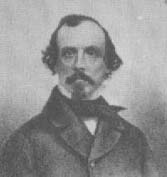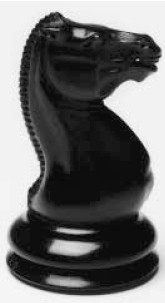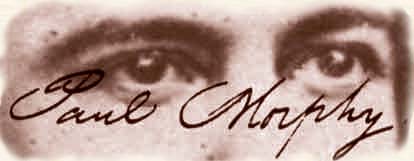 The
Mead incident- The
Mead incident-There has been considerable controversy over an
alleged incident that happened at the New York testimonial banquet on May
25, 1859. The confusion originated in a pamphlet on Morphy written by
Charles A. Buck entitled Paul Morphy: His Later Life and published by
Will H. Lyons in Newport, Kentucky in 1902. The contents of the pamphlet
were first printed in the Evening Gazette of Cedar Rapids, Iowa in
it's December 29, 1900 issue and reprinted in the American Chess World in
it's January 1901 issue. The particular pamphlet has been the source of much
misinformation about Morphy and has lead chess many chess writers, including
Philip Sergeant and Frances Parkinson Keyes, astray.
Colonel Charles Mead
Philip Sergeant, in Morphy's Games of Chess, wrote:
Buck, in "Paul Morphy: His Later Life," describes a dramatic incident
at this presentation. Colonel Charles Mead, as chairman of the reception
committee, made in his address as allusion to chess as a profession, and
referred to Morphy as its most brilliant exponent. "Morphy took
exception to being characterized as a professional player, even by
implication, and he resented it in such a way as to overwhelm Colonel
Mead with confusion. Such was his mortification at this untoward event
that Colonel Mead withdrew from further participation in the Morphy
demonstration."
David Lawson, however, wrote:
No such incident occurred. Contrary to Buck's contention, Colonel
Mead never characterized Morphy as a professional chess player, nor did
he use the word "profession" during the proceedings. Mead introduced the
speakers, mentioning where the chessmen were to be seen, and closed the
meeting as reported by the New York Times. He was also with
Morphy the following evening at another testimonial....
...Mead did not retire in confusion and mortification, but remained
as chairman throughout the proceedings as previously stated.
The Century Club -
Located at at 495 Broadway, the Century Club was founded on January 3,
1847 by members of the former Sketch Club.
According to the Historic Annals of the National Academy of Design
(Philadelphia, 1865):
THE NATIONAL ACADEMY OF DESIGN
A society of American painters and sculptors, whose headquarters is in New
York City. The first Academy of Arts in New York City was founded in 1802 by
prominent citizens, among whom was only one professional artist, Trumbull,
but it excited little interest until 1825, when a secession of the younger
artists occurred. Dissatisfied with the character of the old society,
they formed a new association, called the New York Drawing Association,
directed by practical artists. The present name was adopted in 1828, and the
society, composed of thirty members, was incorporated. Prof. S. F. B. Morse
(q.v.) was the chief organizer of the movement, and was twice president of
the National Academy, in 1827-45 and again in 1861-62. In this capacity he
delivered the first lecture on the fine arts ever given in America. The
Sketch Club, formed by C.C. Ingham, one of the original members of the
National Academy of Design, afterwards became the Century Club (1846). The
National Academy is founded on the plan of the Royal Academy of London, and
its active members are divided into academicians and associates,
the number being limited to one hundred, the only qualification that they be
professional artists. There are also honorary members and fellows of the
Academy who have certain privileges. The society is governed by a council
consisting of its officers and six members, and the instructors in the
school of design are chosen from among its ranks. The Academy stands for the
conservative, traditional element in art, as opposed to the more modern
sentiments which were represented in the earlier work of the Society of
American Artists (q.v.). It held its seventy-eighth annual exhibition in
1903. At these exhibitions the Clarke prize of $300, and the Hallgarten
prizes of $300, $200, and $100, respectively, are distributed, and the
Inness gold medal for the best landscape. The school of design connected
with the Academy has been in existence since 1825, and the instruction
includes classes in the antique, life, still life, anatomy, painting,
perspective, composition, etching, and medal and coin engraving. These
classes are open from October until May, and are free to students admitted
on the evidence of the school committee. The average attendance of pupils is
about 300.
Some of the founding members included William Jones Hoppin, diplomatist,
writer; Dudley B. Fuller , manufacturer; John Gadsby Chapman, artist.

This Knight belonged to Morphy, though not from the set
presented to him at the New York Testimonial. According to Philip
Sergeant, the chessboard was valued at $2000 (in 1859 money) with ebony and
mother-of-pearl squares, while the chessmen, valued at $1500, were of gold
and silver: gold representing the forces of civilization and silver
representing the forces of barbarism.
Read a
detailed description (with sketches) of Morphy's testimonial chessmen and
chessboard!
After Morphy's death both the board and pieces were auctioned off and became
the property of Walter D. Denegre, a gentleman from New Orleans who acted as
a middleman for an unknown client. For a long
time there wasn't any hint of their whereabouts. Then the British Chess
Magazine mentioned in it's December 1885 issue that the "gold and silver men
were offered for sale to the St. George's Chess Club 'at the rather
prohibited price of £1,000.'"
In the early 20th century
John Frederick Keeble, a chess player/problem composer/chess historian who
lived from 1855 to 1939, made an effort to trace their location. He manage
to follow the trail to Count Gasquet (of France, but living in New Orleans)
who claimed to have obtained the chessboard but was unaware of the location
of the pieces. The trail grew
cold after that . The board and pieces are still unaccounted for today.
Morphy had pawned his watch to his friend Arnous de Rivière to finance
his lawsuit against his brother-in-law, John Darius Sybrandt.
W. J. A. Fuller claimed that Rivière showed him the watch at the café de
Régence in 1885. Augustus Mongredien's son claimed to
have seen the watch in Paris in 1921 where it was offered for sale at the
price of 6,000 francs by the heirs of de Rivière.
"The board, which had mother-of-pearl and
ebony squares, was of rosewood inlaid with silver, and at each corner
were the letters P.M. in a wreath of gold. On a silver plate on
one border was the inscription: To Paul Morphy, a recognition of his
genius and a testimony of regard from the friends and admirers in New
York and Brooklyn, 1859. On the opposite border was another silver
plate, bearing the names of fourteen players with claims to the chess
championship of the world.
The men were of solid gold, representing Romans, and
silver, representing Barbarians, and they were mounted on bases of
cornelian.
The watch had a stem surmounted by a coronet, studded
with diamonds and the places of the numerals were taken by
representations of the chess pieces in red and black. On the case were
the initials P.M., the arms of the United States, and the
inscription: To Paul Morphy from the testimonial Committee of the New
York Chess Club, as their tribute to his genius and worth. New York, May
1859.
When the presentation had been made, with many
flattering words, Morphy expressed his thanks in a speech of which one
passage may be quoted:
'A word now on the game itself. Chess never has been and never can
be aught but a recreation. It should not be indulged in to the
detriment of other and more serious avocations - should not absorb or
engross the thoughts of those who worship at its shrine, but should be
kept in the background, and restrained within its proper province. As
a mere game, a relaxation from the severe pursuits of life, it is
deserving of high commendation.'"
Morphy Gleanings by Philip Sergeant
|

